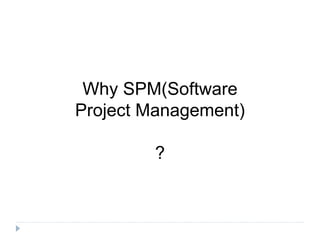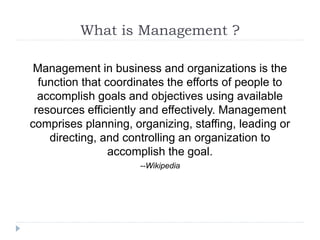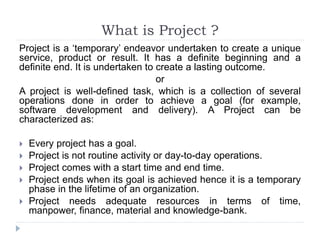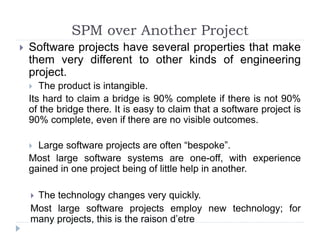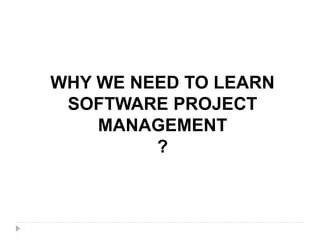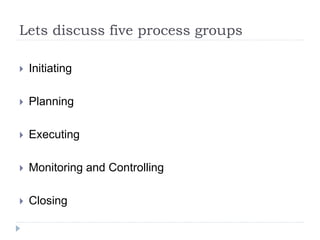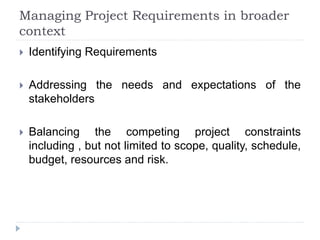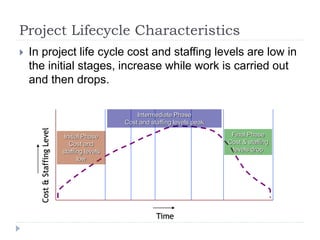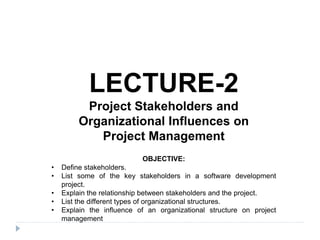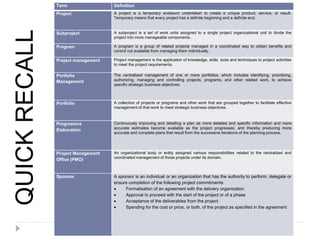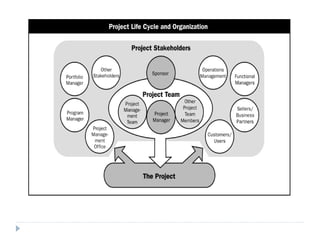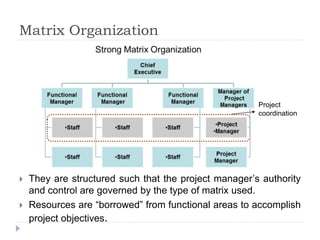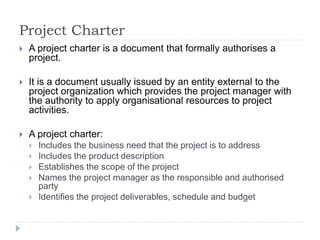Project Management Fundamentals
- 1. SOFTWARE PROJECT MANAGEMENT (Introduced in 2013 by IBM) Nishant Kumar
- 2. LECTURE-1 Basic Definitions OBJECTIVE • Define a project management • Define the following terms Project Sub-Project Program Portfolio Management • List the phases of the project life cycle.
- 4. What is Management ? Management in business and organizations is the function that coordinates the efforts of people to accomplish goals and objectives using available resources efficiently and effectively. Management comprises planning, organizing, staffing, leading or directing, and controlling an organization to accomplish the goal. --Wikipedia
- 5. What is Project ? Project is a ‘temporary’ endeavor undertaken to create a unique service, product or result. It has a definite beginning and a definite end. It is undertaken to create a lasting outcome. or A project is well-defined task, which is a collection of several operations done in order to achieve a goal (for example, software development and delivery). A Project can be characterized as: Every project has a goal. Project is not routine activity or day-to-day operations. Project comes with a start time and end time. Project ends when its goal is achieved hence it is a temporary phase in the lifetime of an organization. Project needs adequate resources in terms of time, manpower, finance, material and knowledge-bank.
- 6. Project Management Project Management is the application of knowledge, skills, tools and techniques to project activities to meet the project requirements.
- 7. Software Project Management is…. A Software Project is the complete procedure of software development from requirement gathering to testing and maintenance, carried out according to the execution methodologies, in a specified period of time to achieve intended software product. Software project management is the art and science of planning and leading software projects.It is a sub-discipline of project management in which software projects are planned, implemented, monitored and controlled.
- 8. Software projects have several properties that make them very different to other kinds of engineering project. The product is intangible. Its hard to claim a bridge is 90% complete if there is not 90% of the bridge there. It is easy to claim that a software project is 90% complete, even if there are no visible outcomes. Large software projects are often “bespoke”. Most large software systems are one-off, with experience gained in one project being of little help in another. The technology changes very quickly. Most large software projects employ new technology; for many projects, this is the raison d’etre SPM over Another Project
- 9. WHY WE NEED TO LEARN SOFTWARE PROJECT MANAGEMENT ?
- 10. To deliver a quality product. To keep cost within clients budget. Tracking of project stages. Accomplishing task as per schedule.
- 11. Lets discuss five process groups Initiating Planning Executing Monitoring and Controlling Closing
- 12. Managing Project Requirements in broader context Identifying Requirements Addressing the needs and expectations of the stakeholders Balancing the competing project constraints including , but not limited to scope, quality, schedule, budget, resources and risk.
- 13. Portfolio Management Portfolio management is a centralized management of one or more portfolios. It includes identifying, prioritizing, authorizing, managing and controlling projects, programs, and other related work, to achieve specific strategic business objectives. Example: An infrastructure firm that has the strategic objective of maximizing the return on its investments may put together a portfolio that includes a mix of projects in oil and gas, water, roads, rail and airports. For this mix, the firm may choose to manage related projects as one program. All of the power projects may be grouped together as a power program.
- 14. Project Phases Project phases are components of the project life cycle. They are divisions within a project where extra control is needed to effectively manage the completion of a major deliverable. It can be sequential or can overlap. They mainly facilitate ease of management, planning and control. Project phases can be mapped to the following life cycle structure irrespective of size or project complexity: 1. Initiating the project 2. Organizing and preparing 3. Carrying out the project work 4. Closing the project
- 15. Project Lifecycle Characteristics In project life cycle cost and staffing levels are low in the initial stages, increase while work is carried out and then drops. Initial Phase Cost and staffing levels low Final Phase Cost & staffing levels drop Intermediate Phase Cost and staffing levels peak Time Cost&StaffingLevel
- 16. … The cost of changes and correcting errors typically increases substantially as the project approaches completion. Stakeholder influence, risk and uncertainty are high in the initial stages, dropping over the life of the project.
- 17. Term Definition Project A project is a temporary endeavor undertaken to create a unique product, service, or result. Temporary means that every project has a definite beginning and a definite end. Subproject A subproject is a set of work units assigned to a single project organizational unit to divide the project into more manageable components. Program A program is a group of related projects managed in a coordinated way to obtain benefits and control not available from managing them individually. Project management Project management is the application of knowledge, skills, tools and techniques to project activities to meet the project requirements. Portfolio Management The centralized management of one or more portfolios, which includes identifying, prioritizing, authorizing, managing and controlling projects, programs, and other related work, to achieve specific strategic business objectives. Portfolio A collection of projects or programs and other work that are grouped together to facilitate effective management of that work to meet strategic business objectives. Progressive Elaboration Continuously improving and detailing a plan as more detailed and specific information and more accurate estimates become available as the project progresses, and thereby producing more accurate and complete plans that result from the successive iterations of the planning process. Project Management Office (PMO) An organizational body or entity assigned various responsibilities related to the centralized and coordinated management of those projects under its domain. Sponsor A sponsor is an individual or an organization that has the authority to perform, delegate or ensure completion of the following project commitments: Formalisation of an agreement with the delivery organization Approval to proceed with the start of the project or of a phase Acceptance of the deliverables from the project Spending for the cost or price, or both, of the project as specified in the agreement QUICKRECALL
- 18. Assignment Discuss the phases in your projects.
- 19. LECTURE-2 Project Stakeholders and Organizational Influences on Project Management OBJECTIVE: • Define stakeholders. • List some of the key stakeholders in a software development project. • Explain the relationship between stakeholders and the project. • List the different types of organizational structures. • Explain the influence of an organizational structure on project management
- 20. Term Definition Project A project is a temporary endeavor undertaken to create a unique product, service, or result. Temporary means that every project has a definite beginning and a definite end. Subproject A subproject is a set of work units assigned to a single project organizational unit to divide the project into more manageable components. Program A program is a group of related projects managed in a coordinated way to obtain benefits and control not available from managing them individually. Project management Project management is the application of knowledge, skills, tools and techniques to project activities to meet the project requirements. Portfolio Management The centralized management of one or more portfolios, which includes identifying, prioritizing, authorizing, managing and controlling projects, programs, and other related work, to achieve specific strategic business objectives. Portfolio A collection of projects or programs and other work that are grouped together to facilitate effective management of that work to meet strategic business objectives. Progressive Elaboration Continuously improving and detailing a plan as more detailed and specific information and more accurate estimates become available as the project progresses, and thereby producing more accurate and complete plans that result from the successive iterations of the planning process. Project Management Office (PMO) An organizational body or entity assigned various responsibilities related to the centralized and coordinated management of those projects under its domain. Sponsor A sponsor is an individual or an organization that has the authority to perform, delegate or ensure completion of the following project commitments: Formalisation of an agreement with the delivery organization Approval to proceed with the start of the project or of a phase Acceptance of the deliverables from the project Spending for the cost or price, or both, of the project as specified in the agreement QUICKRECALL
- 21. STAKE-HOLDERS Stakeholders are the people or organizations actively involved in the project, or whose interests may be positively or negatively affected by the start or completion of the project. They can positively or negatively affect the project by execution (start) or completion of the project. They may exert influence over the project, its deliverables and on the project team. It can be both internal and external. Some key stakeholders in a software development project: Executive Sponsor or Funding Authority Project Manager Product Manager Project Team Members including Analysts, Developers, Testers and Technical Writers Quality Assurance Team Marketing and Finance Team Government Agencies and Regulatory Bodies Vendors and Sub contractors Business Partners Financial Institutions and Banks, etc.
- 23. Organizational Structure It is of three types Functional Project Based Matrix
- 24. Functional Organization The functional organization is the classical hierarchy. Staff members are grouped by skills, functional specialty, or other common attribute and report to a single individual above them in the hierarchy. Project coordination Chief Executive Functional Manager Functional Manager Functional Manager Staff Staff Staff Staff Staff Staff Functional Organization Coloured boxes indicate staff engaged in project activities
- 25. Advantages Staff is managed by a person with experience in their same specialty who can adequately understand and review their work. Staffers have the opportunity to move up within their functional areas, which gives a reason for them to stay long-term. The company gets the advantage of their expertise and company knowledge over time. Staffers work with others in their field, which allows for knowledge sharing and lateral job moves to learn new skills. Disadvantages Functional areas may have difficulties working with other functional areas. There is often a perception that they are competing with other functional areas for resources and a lack of understanding of what other areas do for the company. So, the accounting department may be upset that its request for an additional headcount is denied, but the company financial results point to a need for additional sales people rather than accountants. As the company grows larger, the functional areas can become difficult to manage due to their size. They can become almost like small companies on their own, with their own cultures, facilities, and management methods. Functional areas may become distracted by their own goals and focus on them, rather than on overall company objectives. For instance, there may be a desire by the I.T. department to implement a new, state-of-the-art computer system, but the overall company objectives support investment in new products instead. Since the unit doesn't have an overview of the entire company, it may focus attention on goals that it believes are important but which are not priorities for top management.
- 26. Project-Based Organization It has a full time project manager who has almost total authority over project decisions, resources, and budget. Project team members report directly to the project manager. Chief Executive Project Manager Project Manager Project Manager Staff Staff Staff Staff Staff Staff Projectized Organization Project coordination
- 27. Matrix Organization They are structured such that the project manager’s authority and control are governed by the type of matrix used. Resources are “borrowed” from functional areas to accomplish project objectives. Project coordination
- 28. Matrix… The advantages of a matrix organisation are: Resource has a home organization to which he/she can return. New ideas and best practices are constantly coming into the project team with the various experiences and skills of different team members. Project manager can focus on project-related activities while the functional manager can handle organizational issues such as performance reviews, pay and benefits, and hiring and termination activities. The challenge of a matrix organisation is: Dual reporting and communication requirement.
- 29. Assignments Discuss the kind of probable influences the various stakeholders have on the project. Discuss the organizational structure in which your projects are executed.
- 30. LECTURE-3 Project Management Processes OBJECTIVE • Recall the stakeholders influence on projects. • Explain the project management processes. • Explain interaction of process groups in a project. • List the knowledge areas in which a project manager requires skills.
- 31. Introduction to Project Management Processes Project process is a set of interrelated actions and activities that are performed to achieve a pre- specified set of products, results, or services. They mainly fall into two major categories: Project Management Processes encompass the tools and techniques involved in applying the skills and capabilities described in the knowledge areas. Product-oriented processes are typically defined by the project life cycle, varying by application area.
- 32. Project management processes are grouped into five categories:
- 34. Initiating Process Group This group defines and authorises a new project or new phase of an existing project by obtaining authorisation to start the project or phase. Initial scope of the project is defined Initial financial resources are committed Internal and external stakeholders are identified Project manager selected (if not already done) The two processes in this group are: Develop Project Charter Identify Stakeholders
- 35. Planning Process Group This group defines and refines project objectives. Project management plan and project documents that will be used to carry out the project are created. Detailing of the plan is done progressively referred to as “rolling wave planning”. 1. Develop project management plan 2. Collect requirements 3. Define scope 4. Create Work Breakdown Structure (WBS) 5. Define activities 6. Sequence activities 7. Estimate activity resources 8. Estimate activity durations 9. Develop schedule 10. Estimate costs 11. Determine budget 12. Plan quality 13. Develop human resource plan 14. Plan communications 15. Plan risk management 16. Identify risks 17. Perform qualitative risk analysis 18. Perform quantitative risk analysis 19. Plan risk responses 20. Plan procurements
- 36. Executing Process Group This group integrates people and other resources to carry out the project management plan for the project. It comprises of 8 processes: 1. Direct and manage project execution. 2. Perform quality assurance 3. Acquire project team 4. Develop project team 5. Manage project team 6. Distribute information 7. Manage stakeholder expectations 8. Conduct procurements
- 37. Monitoring and Controlling Process Group 1. Monitor and control project work 2. Perform integrated change control 3. Verify scope 4. Control scope 5. Control schedule 6. Control costs 7. Perform quality control 8. Report performance 9. Monitor and control risks 10. Administer contracts This group regularly measures and monitors progress to identify variances from the Project Management Plans so that corrective actions can be taken when necessary, to meet project objectives. It comprises of 10 processes:
- 38. Closing Process Group This group formalises acceptance of the product, service or result and brings the project or project phase to an orderly end. It comprises of two processes: Close project or phase Close procurement
- 39. Project Management Knowledge Areas The 42 Processes within the 5 Process Groups, are mapped into 9 Project Management Knowledge Areas: 1. Project Integration Management 2. Project Scope Management 3. Project Time Management 4. Project Cost Management 5. Project Quality Management 6. Project Human Resource Management 7. Project Communications Management 8. Project Risk Management 9. Project Procurement Management
- 40. Assignment Discuss the interaction of process groups in a project.
- 41. LECTURE-4 Project Initiating Processes OBJECTIVE • Define a project charter. • Explain the purpose of using a project charter. • List the different fields that should be present in a project charter. • Explain stakeholder analysis. • Create a stakeholder register.
- 42. Project Charter A project charter is a document that formally authorises a project. It is a document usually issued by an entity external to the project organization which provides the project manager with the authority to apply organisational resources to project activities. A project charter: Includes the business need that the project is to address Includes the product description Establishes the scope of the project Names the project manager as the responsible and authorised party Identifies the project deliverables, schedule and budget
- 43. … The purpose of the Project Charter is to document the: Reasons for undertaking the project Objectives and constraints of the project Directions concerning the solution Identities of the main stakeholders
- 44. Sample Project Charter A sample The project charter contents include: The specific purpose of the project Project objectives and criteria for success High level requirements High level project description High level risks Summary milestone schedule Summary budget Project approval requirements Assigned Project Manager and authority level Name and authority of the sponsor
- 45. Assignment Discuss and develop the project charter for one of your live projects



